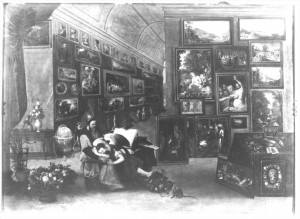The foreground of the Linder Gallery is dominated by two figures, a bearded old man and a young woman in classical clothing reclining in his lap. Whereas the male figure appears to be a portrait, the female figure seems to be purely allegorical. The paintbrushes, maulstick and artist’s pallete would suggest that she can be identified as Painting, or perhaps more broadly as the Arts, given that she is also holding a sculptor’s mallet.
The laurel wreath and sun-pennant worn by the young woman correspond to the attributes of Virtue, according to Cesare Ripa’s Iconologia, a reference text much consulted by artists. If she represents the Arts, perhaps exhausted from her labours in creating all of the paintings and sculpture in the room, then who is the man? The impressive array of astronomical instruments, mathematical tools and diagrams in the painting would seem to suggest that he has something to do with science. The books on the table by Kepler and a physical resemblence to Kepler’s known portraits suggest that the man may be intended as a likeness of astronomer Johannes Kepler. But if so why would a young woman representing the Arts be lying in Kepler’s lap?
There is another painting, now unfortunately lost, which shows a similar composition of a woman representing Painting resting in the lap of an old bearded man. In that painting the old man (with a flaming crown) appears to represent “Disegno” — design or drawing, considered in the seventeenth century as a universal skill embodied in any form of measurement or proportion, from perspective drawing to the measurement of the position of the stars.
So one reading of the allegorical figures in the Linder Gallery is a play on words: “Painting “rests on” Drawing”, or to flesh it out more fully, “The Arts and Virtue rest on Design”, where design includes the sense of moral purpose (as in the phrase “by accident or by design”). This kind of punning and emblematic word play was extremely popular in Flemish painting of the seventeenth century. But why would the astronomer Johannes Kepler be used to represent Design?
There are a few possibilities here:
First, perhaps the male figure is not in fact intended to be Kepler, but just a generic personification of Disegno. That’s possible, but I would suggest, apart from the resemblance and the other references to Kepler in the painting, that the careful way his face is painted strongly follows the conventions of portraiture.
Second, perhaps the painting (informed by mathematician Muzio Oddi) is deliberately putting forward a highly mathematical vision of Design, arguing for the importance of a deep understanding of geometry, astronomy and astrology to all the arts. In this case, if you wanted a person to embody mathematical skill in the late 1620s, Kepler as the Imperial mathematician who had just published the most important planetary tables for more than a century seems like a pretty good candidate. However, in spite of the very clear references to Kepler in the painting, we have yet to discover any direct links between Muzio Oddi or Peter Linder and Kepler — the search continues.



Comments 5
The Gallery Interior with Personifications of Pictura and Disegno is not, in fact, lost. It resurfaced on the art market a while ago, attributed to Hieronymus Francken II and Jan Brueghel, and is now in a private collection.
Thanks for that Alex! Do you have the reference for the sale? Would be very interesting to see that painting as the reproductions we have are so mediocre. There’s also that other lost painting showing the same room without the figures, don’t suppose that one has turned up too?
Yes – it was a Christie’s sale. Here’s a link to the lot (without a picture, but the printed catalogue has it):
http://www.christies.com/LotFinder/lot_details.aspx?intObjectID=3061478
The table on the far right of The Gallery Interior with Personifications is tipped forward in the same wonky way as the Linder Gallery. I know it’s not much of an incredible realization, but thought I’d point it out anyway as it caught my eye.
– Just another person fascinated with this picture.
This reading of the relationship between the old man and the girl doesn’t really depend on my earlier comment about the possibility that the old man is blind (though if he were this would point to the notion of the blind seer who because of his physical disaability sees the more deeply through the eye of his mind). Rather than anything as specific as Science or Disegno, might he not stand for the power of the intellect without whose touch the visual arts sprawl slumbering in disarray?